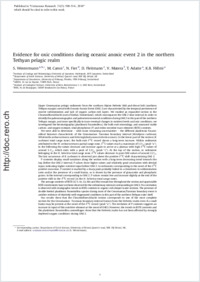Evidence for oxic conditions during oceanic anoxic event 2 in the northern Tethyan pelagic realm
- Westermann, S. Institute of Geology and Paleontology, University of Lausanne, Switzerland - Department of Earth Sciences, University of Bristol, UK
- Caron, Michèle Department of Geosciences, University of Fribourg, Switzerland
- Fiet, N. AREVA, Paris, France
- Fleitmann, D. Institute of Geological Sciences, University of Bern, Switzerland
- Matera, V. INRS, Vandoeuvre-Les-Nancy, France
- Adatte, T. Institute of Geology and Paleontology, University of Lausanne, Switzerland
- Föllmi, K. B. Institute of Geology and Paleontology, University of Lausanne, Switzerland
-
15.07.2010
Published in:
- Cretaceous Research. - 2010, vol. 31, no. 5, p. 500-514
OAE 2
Cenomanian–Turonian boundary
Palaeoceanography
Redox-sensitive trace elements
Phosphorus
Helvetic realm
Alps
Switzerland
English
Upper Cenomanian pelagic sediments from the northern Alpine Helvetic fold-and-thrust belt (northern Tethyan margin) coeval with Oceanic Anoxic Event (OAE) 2 are characterized by the temporal persistence of micrite sedimentation and lack of organic carbon-rich layers. We studied an expanded section in the Chrummflueschlucht (east of Euthal, Switzerland), which encompasses the OAE 2 time interval. In order to identify the paleoceanographic and paleoenvironmental conditions during OAE 2 in this part of the northern Tethyan margin, and more specifically to trace eventual changes in nutrient levels and oxic conditions, we investigated the biostratigraphy (planktonic foraminifera), the bulk-rock mineralogy, and measured stable carbon- and oxygen-isotopes, total phosphorus (P) and redox-sensitive trace-element (RSTE) contents.We were able to determine – with some remaining uncertainties – the different planktonic foraminiferal biozones characteristic of the Cenomanian–Turonian boundary interval (Rotalipora cushmani, Whiteinella archaeocretacea and Helvetoglobotruncana helvetica zones). In the lower part of the section (R. cushmani total range zone), the bulk-rock δ¹³C record shows a long-term increase. Within sediments attributed to the W. archaeocretacea partial range zone, δ¹³C values reach a maximum of 3.3‰ (peak “a”). In the following the values decrease and increase again to arrive at a plateau with high δ¹³C values of around 3.1‰, which ends with a peak of 3.3‰ (peak “c”). At the top of the section, in sediments belonging to the H. helvetica total range zone, δ¹³C values decrease to post-OAE values of around 2.2‰. The last occurrence of R. cushmani is observed just above the positive δ¹³C shift characterizing OAE 2.P contents display small variations along the section with a long-term decreasing trend towards the top. Before the OAE 2 interval, P values show higher values and relatively good covariation with detrital input, indicating higher nutrient input before OAE 2. In sediments corresponding to the onset of the δ¹³C positive excursion, P content is marked by a sharp peak probably linked to a slowdown in sedimentation rates and/or the presence of a small hiatus, as is shown by the presence of glauconite and phosphatic grains. In the interval corresponding to OAE 2, P values remain low and increase slightly at the end of the positive shift in the δ¹³C record (in the H. helvetica total range zone).The average contents of RSTE (U, V, As, Co, Mo and Mn) remain low throughout the section and appreciable RSTE enrichments have not been observed for the sedimentary interval corresponding to OAE 2. No correlation is observed with stratigraphic trends in RSTE contents in organic-rich deeper-water sections. The presence of double-keeled planktonic foraminifera species during most of the Cenomanian/Turonian boundary event is another evidence of relatively well-oxygenated conditions in this part of the northern Tethyan outer shelf.Our results show that the Chrummflueschlucht section corresponds to one of the most complete section for the Cenomanian–Turonian boundary interval known from the Helvetic realm even if a small hiatus may be present at the onset of the δ¹³C record (peak “a”). The evolution of P contents suggests an increase in input of this nutritive element at the onset of OAE2. However, the trends in RSTE contents and the planktonic foraminifera assemblages show that the Helvetic realm has not been affected by strongly depleted oxygen conditions during OAE 2.
- Faculty
- Faculté des sciences et de médecine
- Department
- Département de Géosciences
- Language
-
- English
- Classification
- Palaeontology
- License
- License undefined
- Identifiers
-
- RERO DOC 21084
- DOI 10.1016/j.cretres.2010.07.001
- Persistent URL
- https://folia.unifr.ch/unifr/documents/301805
Statistics
Document views: 79
File downloads:
- car_eoc.pdf: 221
